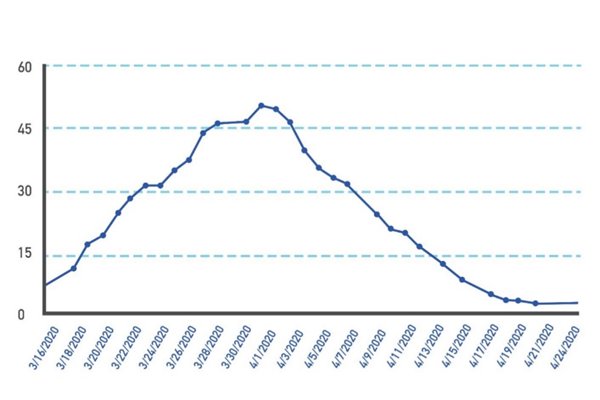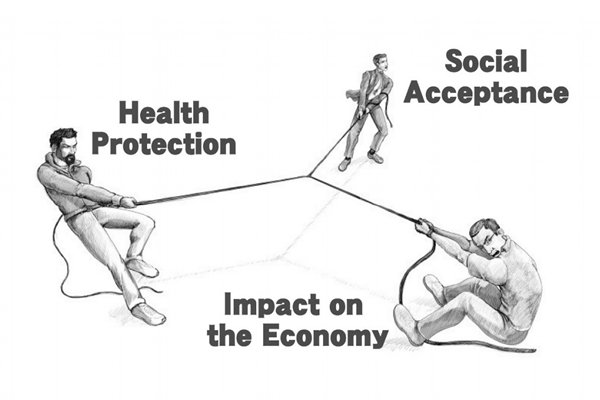HK continues to fight COVID-19
Chief Executive Carrie Lam
During the third month of our fight against COVID-19, Hong Kong has experienced daunting challenges posed by the epidemic with no room to let down our guard. Though we are a bit relieved to see a significant drop in the number of confirmed cases recently, the Government needs to remain alert given the volatility of the epidemic.
Developments of the epidemic
In the past month, the epidemic continued to spread rapidly in many countries around the world. The number of confirmed cases increased from 400,000 a month ago to 2.6 million today, an increase of some 600%, with over 180,000 deaths. Many governments had little choice but to take extreme measures such as a city lockdown. During the same period, the overseas epidemic situation resulted in a large number of Hong Kong residents abroad, including students studying in the United States and Europe, particularly in the United Kingdom, to return to Hong Kong. Due to the large number of imported cases, Hong Kong’s epidemic situation, which had remained stable for a period up to mid-March, started to become severe and reached its peak at the end of March. On March 27, 28 and 29, Hong Kong recorded 65, 64 and 59 confirmed cases respectively on a single day. We were then extremely worried because if 60 new cases have to be admitted to hospital and placed in isolation each day (according to Hospital Authority statistics every confirmed case stays in hospital for 15 to 20 days on average) and if this number of new confirmed cases continued for one month then the Hospital Authority’s 1,200 or so isolation beds would be fully occupied and our hospital system would face unimaginable pressure.
Although deeply anxious, we did not lose our composure but continued to respond promptly to the developments of the epidemic taking account of expert advice. We bit the bullet and resolutely took stringent measures in response to the situation. The number of confirmed cases has dropped from the peak at end-March to single digits since April 12, with the great majority of cases being imported or their close contacts (See Graphic 1). This shows we have prevented local transmission and that Hong Kong, once again, has overcome the challenge.
Anti-epidemic efforts
Since the Government implemented stringent border control measures before end-March, including denying the entry to Hong Kong by plane of all non-Hong Kong residents arriving from overseas countries or regions from March 25, the anti-epidemic measures introduced over the past month focused on enhancing virus testing for inbound travellers and restricting social interactions to prevent the spread of the disease. However, we have not prohibited people from going out as many overseas countries have done. Most restaurants and shops have remained open. People by and large can maintain their daily life.
Major measures implemented by the Government to respond to the developments of the epidemic in the past month are set out in the following table:
|
Date |
Event |
|
March 25-26 |
Four chartered flights were sent over two days to bring back to Hong Kong the second batch of 558 Hong Kong residents stranded in Hubei Province. |
|
March 25-26 |
The Centre for Health Protection (CHP) extended the Enhanced Laboratory Surveillance Programme and set up a temporary specimen collection centre at AsiaWorld-Expo to provide virus testing for asymptomatic inbound travellers arriving from the UK and other countries in Europe as well as the US. |
|
March 27 |
The Government announced that catering premises must comply with six disease control requirements and six types of premises (ie amusement game centres, bathhouses, fitness centres, places of amusement, places of public entertainment and premises for hire for holding social gatherings) must close from 6pm on March 28; and gatherings of more than four people in a public place would be prohibited from midnight on March 29. At the same time, the Chief Executive announced the preparation of the second round of the Anti-epidemic Fund to provide further assistance to individuals and businesses. |
|
April 1-2 |
The Government announced that karaoke establishments, mahjong-tin kau establishments and nightclubs must be closed and beauty parlours, clubhouses and massage establishments must step up epidemic control measures from 6pm on April 1; and bars must close from 6pm on April 3. |
|
April 5 |
Sixty-five Hong Kong residents who took the chartered flights arranged by the Hong Kong Special Administrative Region Government arrived in Hong Kong from Peru. Upon arrival, they were taken to the temporary specimen collection centre at AsiaWorld-Expo to undergo virus testing and were admitted to hospital or put under home quarantine subject to the test results. |
|
April 8 |
The Government announced the closure of beauty parlours and massage establishments from midnight on April 10, and the extension of measures regulating catering businesses and scheduled premises as well as prohibiting group gatherings until April 23. |
|
April 8 |
The Chief Executive announced the second round of the Anti-epidemic Fund and other related measures involving over $130 billion, including an $80 billion Employment Support Scheme. The Legislative Council Finance Committee approved the funding on April 18. |
|
April 8 |
The Department of Health (DH) mandated all asymptomatic inbound travellers arriving at the Hong Kong International Airport to proceed to the temporary specimen collection centre to collect deep throat saliva samples according to instructions before undergoing compulsory quarantine at their place of accommodation. Besides, specimen collection containers will be provided to inbound travellers arriving via land boundary control points who have been to Hubei Province in the past 14 days. |
|
April 9 |
The DH required all asymptomatic inbound travellers arriving on flights from the UK to stay and wait for the test results at the temporary specimen collection centre, and they can continue their quarantine at their place of accommodation only if the test result is negative. The arrangement was extended to asymptomatic inbound travellers arriving on flights from the US and other areas in Europe from April 13. |
|
April 10 |
Twenty-seven Hong Kong residents who left Morocco on a chartered flight arranged by the Chinese Embassy in the Kingdom of Morocco arrived in Guangzhou. Apart from one Hong Kong resident who chose to stay in Guangzhou, all others returned to Hong Kong by prearranged coaches and were taken to AsiaWorld-Expo to undergo virus testing. |
|
April 11 |
To ensure adequate quarantine facilities to cope with the development of the epidemic, the CHP will, where necessary, arrange for people under compulsory quarantine to stay at quarantine centres for the first 10 days and then continue quarantine at home for the remaining four days after virus testing. |
|
April 19 |
The DH required all asymptomatic inbound travellers arriving on flights landing in the morning to stay and wait for the test results at the temporary specimen collection centre. They can continue quarantine at their place of accommodation only if the test result is negative. |
|
April 19 |
With a declining number of inbound travellers, the Hospital Authority suspended the operation of the test centre at AsiaWorld-Expo from noon. Inbound travellers with symptoms will be admitted to public hospitals to undergo testing. |
|
April 20 |
The DH started a trial to provide an extra specimen collection container to inbound travellers arriving at the Hong Kong International Airport for the submission of samples for another round of virus testing (on the 12th day) before the completion of home quarantine. The quarantine can be completed only if the test result is negative. |
|
April 21 |
The Government announced the extension of all statutory measures to enhance social distancing for 14 days until May 7. |
|
April 22 |
The DH required all asymptomatic inbound travellers arriving on flights landing in the afternoon or at night to stay and wait for virus test results at the holding centre in the Regal Oriental Hotel. They can continue quarantine at their place of accommodation only if the test result is negative. Upon implementation of the measure, all inbound travellers arriving at Hong Kong International Airport will be required to undergo testing and can return to the community only if the test result is negative. |
The decision to extend various enhanced social distancing measures to early May is no doubt a further blow to the affected business sectors. The Government fully understands the disappointment and frustration of these sectors, but we dare not let down our guard as we look at the second or third wave of outbreaks around the world. In addressing the public health crisis, the Government also needs to consider the impact of the measures on the economy, livelihood and the daily lives of people. I recall that Prof Gabriel Leung, one of the experts for the Government’s anti-epidemic work, once described the difficulty of the Government in making its decisions as a three-way tug of war (See Graphic 2).
We will continue to listen to the views of the experts and various sectors and constantly adjust the suppress and lift strategy according to the actual situation of the epidemic. The target is to achieve the optimal level of controls at all times.
Supporting individuals and businesses affected by the disease
The epidemic has lasted for more than three months and presents unprecedented challenges to our economy. Many businesses are facing pressure to close down or resort to massive staff layoffs, and many families and members of the public are facing severe hardship. According to the latest labour force statistics released by the Census & Statistics Department, the seasonally adjusted unemployment rate for January to March 2020 increased worryingly to 4.2%, the highest level in over nine years.
The Government will continue to make an all-out effort to keep our workers employed, relieve the financial burden of businesses and members of the public, and pave the way for post-epidemic economic recovery. The two rounds of the Anti-epidemic Fund and related relief measures, together with the relief package in the 2020-21 Budget announced by the Financial Secretary earlier on (yet to be approved by the LegCo), amount to $287.5 billion, representing 10% of gross domestic product. These measures are being implemented progressively to help businesses and members of the public tide over the difficult times.
Fighting the virus together
The hard-earned results of our anti-epidemic work over the past month are due to the togetherness of the community at large, the unswerving commitment of our healthcare professionals, the collaborative efforts of various government departments and the understanding of all sectors in society. I am confident that Hong Kong will come through the epidemic and the economic downturn. As long as we can hold on for some more time, we will soon see a bright tomorrow.
Chief Executive Carrie Lam issued this article entitled Three Months into Our Fight Seeing the Arrival of Dawn on April 25.

